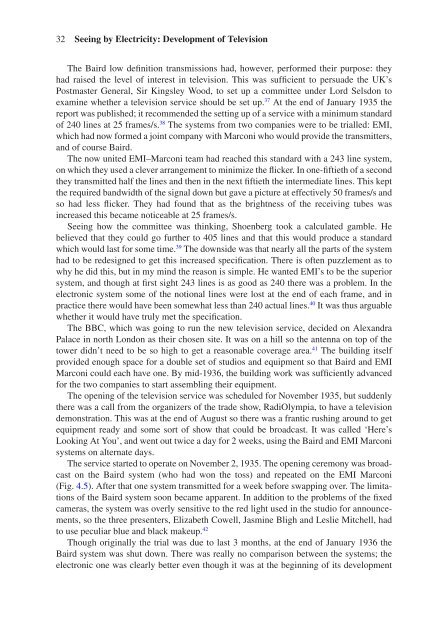The Electronics Revolution Inventing the Future
Create successful ePaper yourself
Turn your PDF publications into a flip-book with our unique Google optimized e-Paper software.
32 Seeing by Electricity: Development of Television<br />
<strong>The</strong> Baird low definition transmissions had, however, performed <strong>the</strong>ir purpose: <strong>the</strong>y<br />
had raised <strong>the</strong> level of interest in television. This was sufficient to persuade <strong>the</strong> UK’s<br />
Postmaster General, Sir Kingsley Wood, to set up a committee under Lord Selsdon to<br />
examine whe<strong>the</strong>r a television service should be set up. 37 At <strong>the</strong> end of January 1935 <strong>the</strong><br />
report was published; it recommended <strong>the</strong> setting up of a service with a minimum standard<br />
of 240 lines at 25 frames/s. 38 <strong>The</strong> systems from two companies were to be trialled: EMI,<br />
which had now formed a joint company with Marconi who would provide <strong>the</strong> transmitters,<br />
and of course Baird.<br />
<strong>The</strong> now united EMI–Marconi team had reached this standard with a 243 line system,<br />
on which <strong>the</strong>y used a clever arrangement to minimize <strong>the</strong> flicker. In one-fiftieth of a second<br />
<strong>the</strong>y transmitted half <strong>the</strong> lines and <strong>the</strong>n in <strong>the</strong> next fiftieth <strong>the</strong> intermediate lines. This kept<br />
<strong>the</strong> required bandwidth of <strong>the</strong> signal down but gave a picture at effectively 50 frames/s and<br />
so had less flicker. <strong>The</strong>y had found that as <strong>the</strong> brightness of <strong>the</strong> receiving tubes was<br />
increased this became noticeable at 25 frames/s.<br />
Seeing how <strong>the</strong> committee was thinking, Shoenberg took a calculated gamble. He<br />
believed that <strong>the</strong>y could go fur<strong>the</strong>r to 405 lines and that this would produce a standard<br />
which would last for some time. 39 <strong>The</strong> downside was that nearly all <strong>the</strong> parts of <strong>the</strong> system<br />
had to be redesigned to get this increased specification. <strong>The</strong>re is often puzzlement as to<br />
why he did this, but in my mind <strong>the</strong> reason is simple. He wanted EMI’s to be <strong>the</strong> superior<br />
system, and though at first sight 243 lines is as good as 240 <strong>the</strong>re was a problem. In <strong>the</strong><br />
electronic system some of <strong>the</strong> notional lines were lost at <strong>the</strong> end of each frame, and in<br />
practice <strong>the</strong>re would have been somewhat less than 240 actual lines. 40 It was thus arguable<br />
whe<strong>the</strong>r it would have truly met <strong>the</strong> specification.<br />
<strong>The</strong> BBC, which was going to run <strong>the</strong> new television service, decided on Alexandra<br />
Palace in north London as <strong>the</strong>ir chosen site. It was on a hill so <strong>the</strong> antenna on top of <strong>the</strong><br />
tower didn’t need to be so high to get a reasonable coverage area. 41 <strong>The</strong> building itself<br />
provided enough space for a double set of studios and equipment so that Baird and EMI<br />
Marconi could each have one. By mid-1936, <strong>the</strong> building work was sufficiently advanced<br />
for <strong>the</strong> two companies to start assembling <strong>the</strong>ir equipment.<br />
<strong>The</strong> opening of <strong>the</strong> television service was scheduled for November 1935, but suddenly<br />
<strong>the</strong>re was a call from <strong>the</strong> organizers of <strong>the</strong> trade show, RadiOlympia, to have a television<br />
demonstration. This was at <strong>the</strong> end of August so <strong>the</strong>re was a frantic rushing around to get<br />
equipment ready and some sort of show that could be broadcast. It was called ‘Here’s<br />
Looking At You’, and went out twice a day for 2 weeks, using <strong>the</strong> Baird and EMI Marconi<br />
systems on alternate days.<br />
<strong>The</strong> service started to operate on November 2, 1935. <strong>The</strong> opening ceremony was broadcast<br />
on <strong>the</strong> Baird system (who had won <strong>the</strong> toss) and repeated on <strong>the</strong> EMI Marconi<br />
(Fig. 4.5). After that one system transmitted for a week before swapping over. <strong>The</strong> limitations<br />
of <strong>the</strong> Baird system soon became apparent. In addition to <strong>the</strong> problems of <strong>the</strong> fixed<br />
cameras, <strong>the</strong> system was overly sensitive to <strong>the</strong> red light used in <strong>the</strong> studio for announcements,<br />
so <strong>the</strong> three presenters, Elizabeth Cowell, Jasmine Bligh and Leslie Mitchell, had<br />
to use peculiar blue and black makeup. 42<br />
Though originally <strong>the</strong> trial was due to last 3 months, at <strong>the</strong> end of January 1936 <strong>the</strong><br />
Baird system was shut down. <strong>The</strong>re was really no comparison between <strong>the</strong> systems; <strong>the</strong><br />
electronic one was clearly better even though it was at <strong>the</strong> beginning of its development


















